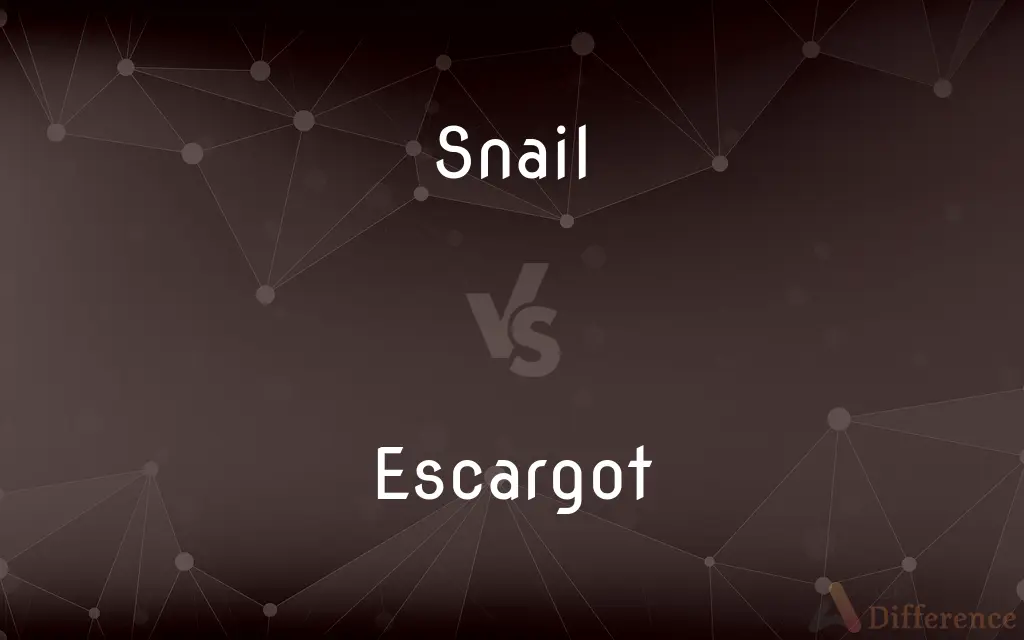Snail vs. Escargot — What's the Difference?
By Fiza Rafique & Maham Liaqat — Updated on April 5, 2024
Snail refers to any gastropod with a coiled shell, living on land or in water. Escargot, on the other hand, is a culinary term for edible land snails, often prepared with garlic butter.

Difference Between Snail and Escargot
Table of Contents
ADVERTISEMENT
Key Differences
Snails encompass a wide variety of gastropods with coiled shells, found both on land and in water, serving various roles in ecosystems. Whereas escargot specifically refers to certain species of land snails considered a delicacy, primarily in French cuisine, often served as an appetizer.
While snails play crucial roles in their habitats, such as decomposers or as part of larger food webs, escargot is valued for its culinary uses, often prepared with butter and garlic, showcasing cultural and gastronomical significance.
On one hand, the term "snail" can apply to thousands of species across different habitats, highlighting the biodiversity among gastropods. On the other hand, "escargot" usually denotes a select few species suitable for human consumption, reflecting a narrow, culinary-focused categorization.
Snails are studied in various scientific fields, including biology and ecology, for their behaviors, reproductive strategies, and environmental adaptations. Conversely, escargot is often discussed in culinary arts, focusing on preparation techniques, flavors, and dietary benefits.
Understanding snails encompasses knowing their ecological impact, species diversity, and evolutionary adaptations. Meanwhile, appreciating escargot involves culinary traditions, preparation methods, and its status as a gourmet food item.
ADVERTISEMENT
Comparison Chart
Definition
A gastropod with a coiled shell.
Edible land snails, prepared as a French delicacy.
Habitat
Both land and water environments.
Primarily land, in gardens and farms.
Significance
Ecological roles such as decomposition.
Culinary significance, especially in French cuisine.
Preparation
Not applicable.
Cooked with garlic, butter, and herbs.
Species Diversity
Thousands of species worldwide.
Focuses on a few species deemed edible.
Compare with Definitions
Snail
Snails can be both herbivorous or omnivorous, feeding on a range of material.
Snails in my garden feed on leaves and decomposing matter.
Escargot
A dish of cooked land snails, typically served as an appetizer in France.
For our anniversary, we started with escargot, which was exquisite.
Snail
Some species of snails are used in aquariums to help control algae.
The mystery snail is popular among aquarium enthusiasts.
Escargot
Eating escargot is considered a part of experiencing French gastronomy.
Trying escargot is a must for any foodie visiting France.
Snail
A mollusk with a single, spiral shell into which the whole body can be withdrawn.
The garden snail is a common sight in moist environments.
Escargot
Escargot snails are often farmed specifically for culinary use.
The escargot we had last night comes from a local snail farm.
Snail
The speed of snails has become synonymous with slowness in many cultures.
He moves at a snail's pace when getting ready in the morning.
Escargot
The utensils for eating escargot include snail tongs and a slender fork.
Eating escargot requires a bit of skill with the special utensils.
Snail
Snails play a vital role in ecosystems by breaking down decomposing matter.
Forest snails contribute to the nutrient cycle by feeding on detritus.
Escargot
Escargot is usually prepared with garlic butter and parsley.
The escargot was so flavorful, thanks to the garlic butter sauce.
Snail
A snail is, in loose terms, a shelled gastropod. The name is most often applied to land snails, terrestrial pulmonate gastropod molluscs.
Escargot
Escargot (French pronunciation: [ɛskaʁɡo] (listen)), from the French word for snail, is a dish consisting of cooked land snails. It is often served as an hors d'oeuvre and is common in France and parts of India (particularly among the Naga people and Manipur).
Snail
Any of numerous aquatic or terrestrial gastropod mollusks that typically have a spirally coiled shell, retractile foot, and distinct head.
Escargot
An edible snail, especially one prepared as an appetizer or entrée.
Snail
A slow-moving, lazy, or sluggish person.
Escargot
(uncountable) A dish, commonly associated with French cuisine, consisting of edible snails.
Snail
Any of very many animals (either hermaphroditic or nonhermaphroditic), of the class Gastropoda, having a coiled shell.
Escargot
(countable) A snail (often Helix pomatia) used in preparation of that dish.
Snail
A slow person; a sluggard.
Escargot
Any edible terrestrial snail prepared as food; as a dish, it is usually served in the shell with a sauce of melted butter and garlic.
Snail
(engineering) A spiral cam, or a flat piece of metal of spirally curved outline, used for giving motion to, or changing the position of, another part, as the hammer tail of a striking clock.
Escargot
Edible terrestrial snail usually served in the shell with a sauce of melted butter and garlic
Snail
A tortoise or testudo; a movable roof or shed to protect besiegers.
Snail
The pod of the snail clover.
Snail
(railroading) A locomotive with a prime mover but no traction motors, used to provide extra electrical power to another locomotive.
Snail
To move or travel very slowly.
Snail
Any one of numerous species of terrestrial air-breathing gastropods belonging to the genus Helix and many allied genera of the family Helicidæ. They are abundant in nearly all parts of the world except the arctic regions, and feed almost entirely on vegetation; a land snail.
Snail
Hence, a drone; a slow-moving person or thing.
Snail
A spiral cam, or a flat piece of metal of spirally curved outline, used for giving motion to, or changing the position of, another part, as the hammer tail of a striking clock.
Snail
A tortoise; in ancient warfare, a movable roof or shed to protect besiegers; a testudo.
They had also all manner of gynes [engines] . . . that needful is [in] taking or sieging of castle or of city, as snails, that was naught else but hollow pavises and targets, under the which men, when they fought, were heled [protected], . . . as the snail is in his house; therefore they cleped them snails.
Snail
The pod of the sanil clover.
Snail
Freshwater or marine or terrestrial gastropod mollusk usually having an external enclosing spiral shell
Snail
Edible terrestrial snail usually served in the shell with a sauce of melted butter and garlic
Snail
Gather snails;
We went snailing in the summer
Common Curiosities
What is escargot?
Escargot is a culinary term for edible land snails, especially prepared with butter and garlic in French cuisine.
Is escargot a French invention?
While escargot is closely associated with French cuisine, the practice of eating snails dates back to prehistoric times and is found in various cultures.
Can I find escargot in a regular supermarket?
In many places, escargot can be found in canned form in supermarkets, but fresh or frozen escargot may require a specialty store.
How are snails and escargot different?
While all escargots are snails, not all snails are considered escargot; escargot refers specifically to those prepared for culinary purposes.
Can any snail be used as escargot?
No, only certain species of land snails are considered suitable and safe for consumption as escargot.
How do you eat escargot?
Escargot is typically eaten with a small fork to extract the meat from the shell, often after using tongs to hold the shell.
What is a snail?
A snail is a gastropod mollusk with a coiled shell, living in various environments, including land and water.
How do you prepare escargot?
Escargot is typically prepared by removing the snails from their shells, cooking them with garlic butter and herbs, and then placing them back in the shells for serving.
Do snails have any predators?
Yes, snails have numerous natural predators, including birds, mammals, reptiles, insects, and even some humans, in the case of escargot.
Is it expensive to eat escargot?
The price of escargot can vary, but it is generally considered a delicacy and can be relatively expensive compared to other dishes.
Are snails healthy to eat?
Yes, snails are high in protein, low in fat, and contain various essential nutrients, making them a healthy food option when prepared properly.
What is the environmental impact of snails?
While snails play important roles in ecosystems, such as decomposition and soil aeration, some species can become pests in gardens and agriculture.
What is the lifespan of a snail?
The lifespan of a snail varies widely among species, ranging from a few years to up to 25 years for some larger species.
How do snails reproduce?
Snails are hermaphrodites, meaning they have both male and female reproductive organs, allowing them to produce eggs after mating with another snail.
Why do people eat snails?
People eat snails for their nutritional value, unique flavor, and texture, as well as for the cultural and culinary experience, especially in regions where it is considered a delicacy.
Share Your Discovery

Previous Comparison
Scissors vs. Shears
Next Comparison
Defensive vs. OffensiveAuthor Spotlight
Written by
Fiza RafiqueFiza Rafique is a skilled content writer at AskDifference.com, where she meticulously refines and enhances written pieces. Drawing from her vast editorial expertise, Fiza ensures clarity, accuracy, and precision in every article. Passionate about language, she continually seeks to elevate the quality of content for readers worldwide.
Co-written by
Maham Liaqat











































